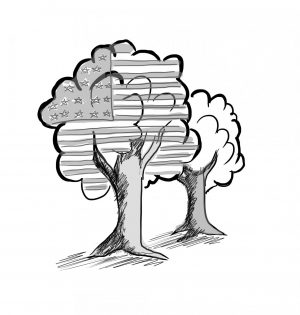Politicizing Nature: Trump’s Wildfire Ignorance
April 11, 2019
The recent horrifyingly devastating wildfires have justifiably raised questions regarding both current forest management techniques and what can be done to avoid future disasters. President Donald Trump and former Secretary of the Interior Ryan Zinke, however, seized upon the recurring and tragic West Coast wildfire phenomenon in order to promote their nefarious political agenda of heavy logging, which they misleadingly branded as “active management” of forests. In multiple interviews, Trump has articulated increasingly bizarre beliefs about the conflagrations. From a nonsensical suggestion to rake forest floors in the (nonexistent) Finnish style to an angry tweet threatening to deprive California of federal disaster relief funding because of perceived inadequate forest management, it is abundantly clear that our commander in chief is simply unable to understand the underlying reasons behind the occurrence of wildfires. Indeed, more intensive logging is simply not the solution to the wildfire epidemic.

Trump and Zinke’s firm belief in the preventable nature of California’s wildfires is profoundly misguided. According to Arizona State University professor and fire expert Stephen J. Pyne, many areas on the West Coast are essentially places that were made to burn, giving the wildfire season a fundamental aura of inevitability. This notion is a foreign one to Zinke, however, who suggested in a USA Today op-ed that “radical environmentalists” are to blame for the fires. In pushing this preposterous narrative, Zinke deliberately ignores the fact that natural events like the enormously powerful Diablo and Santa Ana winds (in Northern and Southern California respectively) rapidly spread embers and naturally promote the expansion of wildfires.
It is also not the inadequate raking of forest floors that propagates wildfires; rather, things like pine needles, dry grass and kindling are what truly feed the blazes. And forests are not the only topographical area of concern for wildfires, which have also devastated chaparral areas, prairies dotted with oak trees, and grasslands. Pyne also notes that typical fires leave behind large, green matter and burn “post-cut debris called slash,” powerfully suggesting that the logging practices favored by the Trump administration are actually what often perpetuate the fires.
A presidential belief that climate change is a Chinese hoax problematically obfuscates the inextricable link between climate change and the recent fires. The extended West Coast wildfire seasons and the increased territorial range of fires are indicative of the effects of climate change. Extreme droughts in particular have been blamed for fires’ increased range, and a decreased amount of precipitation has significantly extended the wildfire season. Also, California is simply highly prone to wildfires — climate change has only served to exacerbate an existing natural phenomenon. The devastating Camp fire roared through an area that had burned 10 years ago, suggesting that almost no preventative measure, and certainly not logging, could have possibly inhibited this particular blaze. Indeed, fire experts have noted that had the area surrounding Paradise, CA received a normal amount of precipitation, the Camp fire would likely have never burned in the first place. The presidential willingness to ignore global warming doesn’t change the incontrovertible fact that climate change has rendered our wildfires more fearsome and devastating than ever before.
Acknowledging the seasonal inevitability of wildfires is absolutely essential. We seem to experience a renewed sense of shock and dismay each passing year during wildfire season, despite the clear warning signs provided by climate change and recent history. But this doesn’t mean that we are completely helpless. We must think hard about the implementation of stronger building codes that prevent homes from being something akin to tinderboxes — houses right now are being destroyed more completely than trees are, a central irony that Trump and Zinke entirely miss when they place the blame for fires on overgrown forests. There is also a pressing need for firebreaks between residential areas and woodlands, an essential step in preventing fires from devastating developed areas and destroying property.
In confronting the wildfire phenomenon, the solution is neither heavy logging nor allowing forests to grow wild. Through practices such as duly prescribed burning and grazing, some of which are already utilized, management of the “buffer” lands in relatively close proximity to residential areas can provide an opportunity to mitigate potential wildfire damage while not wreaking havoc on the land itself. States must also maintain their full-court press in confronting climate change, even if the US government refuses to acknowledge its reality. Through battling climate change, strengthening building codes and careful management of natural spaces, we must do our utmost to prepare for, understand and mitigate this devastating and somewhat inevitable natural phenomenon.




